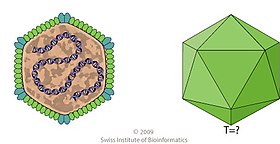Rhizidiovirus: Difference between revisions
WP:CHECKWIKI error fix for #59. Remove br tag at end of template parameter. Do general fixes if a problem exists using AWB (8829) |
Allforrous (talk | contribs) →External links: Commonscat template. |
||
| (28 intermediate revisions by 20 users not shown) | |||
| Line 1: | Line 1: | ||
{{Short description|Genus of viruses}} |
|||
{{Taxobox |
|||
{{Use dmy dates|date=April 2017}} |
|||
| color = violet |
|||
{{Virusbox |
|||
| image = |
|||
| image = F31-01-9780123846846-Rhizidiovirus.png |
|||
| image_width = |
|||
| image_caption |
| image_caption = ''Rhizidiomyces virus'' |
||
| |
| taxon = Rhizidiovirus |
||
| |
| subdivision = |
||
* Rhizidiomyces virus <small>ICTV 1987</small> |
|||
| familia = ''Unassigned'' |
|||
| synonyms = |
|||
| genus = ''Rhizidiovirus'' |
|||
Rhizidiomyces virus |
|||
* RV <small>Virus name abbr.</small> |
|||
| subdivision_ranks = Species |
|||
| subdivision =[[Rhizidiomyces virus]] |
|||
}} |
}} |
||
'''''Rhizidiovirus''''' is a genus of [[viruses]]. [[Stramenopile]]s<ref>Dawe VH, Kuhn CW (1983) Isolation and characterization of a double-stranded DNA mycovirus infecting the aquatic fungus, ''Rhizidiomyces''. Virology 130(1):21–28</ref> (specifically [[Hyphochytridiomycota]]) serve as natural hosts. There is only one species in this genus: '''''Rhizidiomyces virus'''''.<ref name=ViralZone>{{cite web|title=Viral Zone|url=http://viralzone.expasy.org/all_by_species/640.html|publisher=ExPASy|access-date=15 June 2015}}</ref><ref name="ICTV"> {{cite web |title=Virus Taxonomy: 2022 Release |url=https://ictv.global/taxonomy |website=International Committee on Taxonomy of Viruses (ICTV) |access-date=18 August 2023 |language=en |date=March 2023}} </ref> |
|||
== |
==Structure== |
||
[[File:Rhizidiovirus virion.jpg|thumb|left|upright=1.25|Schematic drawing of a ''Rhizidiovirus'' particle]] |
|||
Viruses in ''Rhizidiovirus'' are non-enveloped, with icosahedral, round, and isometric geometries. The diameter is around 60 nm.<ref name=ViralZone /> |
|||
| ⚫ | |||
The viron is non enveloped, isosahedral with a diameter of 60 nanometers (nm). |
|||
{{Clear|left}} |
|||
{| class="wikitable sortable" style="text-align:center" |
|||
|- |
|||
! Genus !! Structure || Symmetry !! Capsid !! Genomic arrangement !! Genomic segmentation |
|||
|- |
|||
|''Rhizidiovirus''||Icosahedral||||Non-enveloped||Linear||Monopartite |
|||
|} |
|||
==Life cycle== |
|||
| ⚫ | |||
| ⚫ | The virus seems to remain latent within the host until the host is stressed.<ref name=Dawe1983>Dawe VH, Kuhn CW (1983) Virus-like particles in the aquatic fungus, ''Rhizidiomyces''. Virology 130(1):10–20.</ref> Virons first appear in the [[Cell nucleus|nucleus]]. This is followed by the disintegration of the host nucleus and [[cytoplasm]] and their replacement by paracrystalline structures composed of virons. These structures first appear in association with the mitochondria. After the nucleus and cytoplasm have been replaced the cell wall breaks down followed with release of virons into the medium. Vertical transmission also appears to be possible.{{cn|date=November 2022}} |
||
DNA-templated transcription is the method of transcription. Fungi and hyphochytridiomycota serve as the natural host.<ref name=ViralZone /> |
|||
| ⚫ | The virus seems to remain latent within the host until the host is stressed.<ref name=Dawe1983>Dawe VH, Kuhn CW (1983) Virus-like particles in the aquatic fungus, ''Rhizidiomyces''.Virology 130(1): |
||
{| class="wikitable sortable" style="text-align:center" |
|||
== Literature == |
|||
|- |
|||
! Genus !! Host details !! Tissue tropism !! Entry details !! Release details !! Replication site !! Assembly site !! Transmission |
|||
|- |
|||
|''Rhizidiovirus''||Fungi Hyphochytridiomycota||None||Unknown||Lysis||Nucleus||Nucleus||Passive Diffusion, Vertical |
|||
|} |
|||
==References== |
|||
{{Reflist}} |
{{Reflist}} |
||
==External links== |
==External links== |
||
* |
{{Commonscat|Rhizidiovirus}} |
||
*[http://viralzone.expasy.org/all_by_species/640.html '''Viralzone''': Rhizidiovirus] |
|||
*[http://ictvonline.org/virusTaxonomy.asp '''ICTV'''] |
|||
{{Baltimore classification}} |
|||
| ⚫ | |||
{{Taxonbar|from1=Q7320734|from2=Q18976667}} |
|||
| ⚫ | |||
[[Category:Virus genera]] |
|||
Latest revision as of 15:57, 11 March 2024
| Rhizidiovirus | |
|---|---|

| |
| Rhizidiomyces virus | |
| Virus classification | |
| (unranked): | Virus |
| Genus: | Rhizidiovirus |
| Species | |
| |
| Synonyms | |
|
Rhizidiomyces virus
| |
Rhizidiovirus is a genus of viruses. Stramenopiles[1] (specifically Hyphochytridiomycota) serve as natural hosts. There is only one species in this genus: Rhizidiomyces virus.[2][3]
Structure[edit]

Viruses in Rhizidiovirus are non-enveloped, with icosahedral, round, and isometric geometries. The diameter is around 60 nm.[2]
The genome is non segmented, linear double stranded DNA (dsDNA) and ~25.5 kilobases in length. It has a guanine + cytosine content of 42%. It encodes at least 14 protein with molecular weights between 84.5 and 26 kilodaltons.[citation needed]
| Genus | Structure | Symmetry | Capsid | Genomic arrangement | Genomic segmentation |
|---|---|---|---|---|---|
| Rhizidiovirus | Icosahedral | Non-enveloped | Linear | Monopartite |
Life cycle[edit]
The virus seems to remain latent within the host until the host is stressed.[4] Virons first appear in the nucleus. This is followed by the disintegration of the host nucleus and cytoplasm and their replacement by paracrystalline structures composed of virons. These structures first appear in association with the mitochondria. After the nucleus and cytoplasm have been replaced the cell wall breaks down followed with release of virons into the medium. Vertical transmission also appears to be possible.[citation needed]
DNA-templated transcription is the method of transcription. Fungi and hyphochytridiomycota serve as the natural host.[2]
| Genus | Host details | Tissue tropism | Entry details | Release details | Replication site | Assembly site | Transmission |
|---|---|---|---|---|---|---|---|
| Rhizidiovirus | Fungi Hyphochytridiomycota | None | Unknown | Lysis | Nucleus | Nucleus | Passive Diffusion, Vertical |
References[edit]
- ^ Dawe VH, Kuhn CW (1983) Isolation and characterization of a double-stranded DNA mycovirus infecting the aquatic fungus, Rhizidiomyces. Virology 130(1):21–28
- ^ a b c "Viral Zone". ExPASy. Retrieved 15 June 2015.
- ^ "Virus Taxonomy: 2022 Release". International Committee on Taxonomy of Viruses (ICTV). March 2023. Retrieved 18 August 2023.
- ^ Dawe VH, Kuhn CW (1983) Virus-like particles in the aquatic fungus, Rhizidiomyces. Virology 130(1):10–20.
